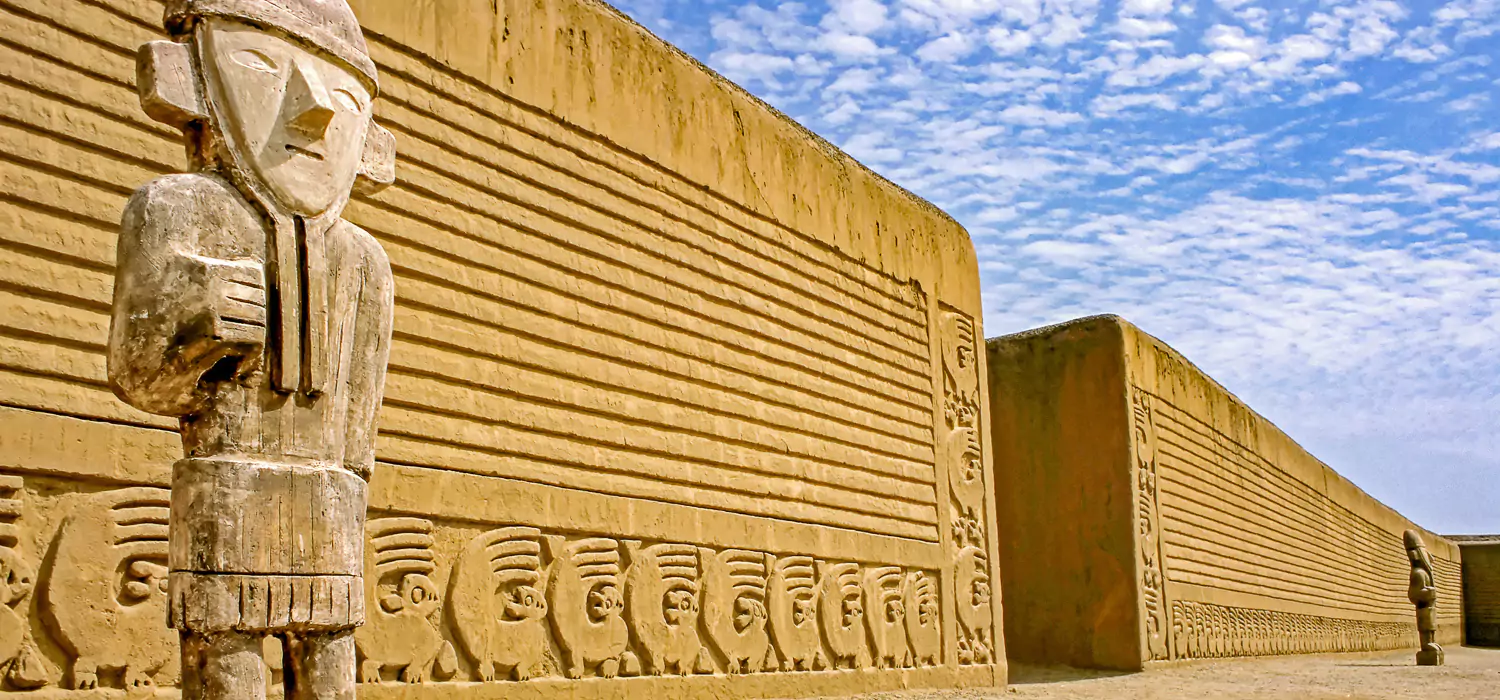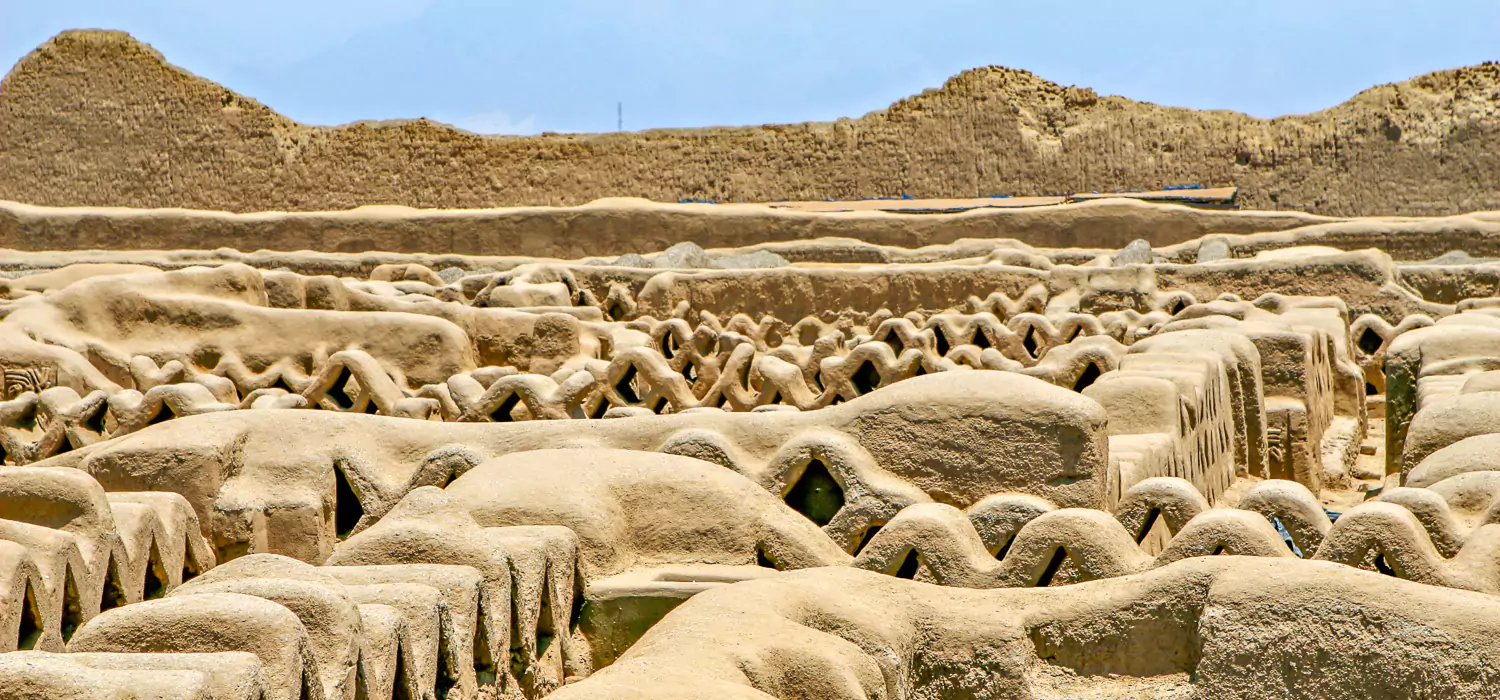HOTELS
ACTIVITIES
WEATHER
GETTING THERE
COMBINE WITH
Peru’s Northern Coast
Peru’s Northern Coast is rightly referred to as a cradle of nations. Throughout the pre-Inca millennia, waves of cultures flourished here. Curiously, compared to the Inca sites of Southern Peru, the North’s ancient cities receive few visitors, allowing the intrepid few to explore in relative privacy.
The largest pre-European city in the Americas, Chan Chan, was constructed by the Chimor culture three miles west of present-day Trujillo. Although it appears arid, the section of the coastal plain is fertile, and was irrigated anciently by an extensive canal network. The site was occupied continuously from approximately 850 AD until the Inca Túpac Yupanqui defeated the Chimor emperor Minchancaman in 1470 AD.

Chan Chan’s Urban Core
At its zenith, Chan Chan’s urban core—divided into ten citadels—covered more than two square miles, much of which was surrounded by adobe walls fifty to sixty feet high. The surrounding settlements filled nearly eight square miles and supported an estimated 30,000 residents.
Most visitors to the site tour a group of three walled plazas known as the Tschudi Complex.
Twenty minutes from Trujillo and not far from Chan Chan, the village of Huanchaco is famous for its traditional fishing techniques. Fishermen straddle small boats—caballitos de totora—made from bound reeds, a design that reportedly dates back 3,000 years.
Temple of the Sun and Temple of the Moon
To the southeast of Chan Chan, two enormous adobe pyramids tower over the surrounding landscape—the Temple of the Sun and the Temple of the Moon. These monuments of the Moche culture were constructed between the first and eighth centuries.

Huaca de la Luna
Huaca de la Luna is decorated with multicolored friezes, one of which covers nearly an entire side of the pyramid. Approximately 160 miles to the north, near the town of Chiclayo, lies the ancient Moche burial site of Sipan, or Huaca Rayada.
The site was excavated in the late 1980s, unearthing a royal tomb filled with gold and silver jewelry. The tomb of this “Lord of Sipan” and reproductions of its contents are displayed in situ.
Túcume
North of Sipan, sits an area known as Túcume—a 540-acre site containing 26 major adobe pyramids and platforms built by the Sican. Constructed on a plain around La Raya Mountain, the site was originally settled around 800 AD.
It continued under Sican control until 1350 AD, likely occupied by successive Chimor and Inca populations in years thereafter. Like Chan Chan, this area is crisscrossed by scores of ancient irrigation canals.
Our Favorite Hotels
What to do Trujillo
Visitors to Trujillo are mostly interested in exploring the North’s ancient cities. LANDED arranges privately guided experiences with our clients’ unique interests in mind. We can help you arrange visits to the above mentioned sites. Although impressive, i is difficult to understand these sites without the direction of an expert guide.

What is the Weather Like?
Trujillo and Chiclayo have pleasant weather year-round, enjoying a hot desert climate. The yearly average maximum temperature in Trujillo is 75°C. November till April see some rain with March being the rainiest month.
These averages are changing, please check extended weather forecasts using your favorite weather app prior to departure.

Getting There
Trujillo can be reached by air from Lima in just over an hour. Flights from the capital reach Chiclayo in about 90 minutes.
Visits to these areas can be combined with extensions to the historic city of Cajamarca and the cultural sites of the mountainous Chachapoyas region.
Start your journey today
LANDED delivers the finest in custom, private travel to Central America, South America, and Antarctica. These regions are our passion; we know them first-hand and by heart. Speak with one of our travel designers and let us create a tailored itinerary for you in Peru’s North Coast.
How to combine The North Coast
Have some extra time? Here are some options for you to combine with

Cusco

Lima

Machu Picchu










